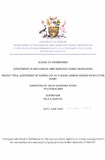| dc.description.abstract | Energy acquisition and use have been of increasing concern. This being a valuable resource, many
people are looking at it with a view of either reducing overall energy used or improving efficiency. An
assessment of energy use was done at CO2 producing plant. The aim of the assessment was to find out
the working condition of equipments and energy use, identify energy saving opportunities and
determine potential savings. The plant is situated 30 kilometers from Nairobi city on Nairobi - Nakuru
road. It produces an average of 11,000 tonnes of CO2 per year and records an average use of 180
kWh/tonne. It has two major sources of energy namely electricity and diesel. Major energy consuming
equipments at the plant include: compressors, motors, fans, refrigeration coolers and lighting.
The assessment was narrowed down to major energy consuming equipment. It was executed in two
phases first being, the plant energy historical data analysis and secondly a detailed assessment which
involved taking site measurements and recordings.
Analysis of historical data shows increase in energy consumption over the years. Intensities had too
much scatters that is associated with inefficient operation. Most of the equipments were found to be in
good working condition. However, a belt at one of the compressor was torn as a result of vibrations
due to misalignment of the compressor and the motor.
w
Analysis of site metered data shows that compressors consumed most of the energy at the plant.
Power consumed at the R22 compressor fluctuated over a long period of time. The plant looses energy
through exposed surfaces which can be insulated. The plant has 67 fluorescent fittings in number that
can be changed to electronic ones. Standard motors used at the plant can be replaced by energy
efficient types. The cooling process utilizes a heat exchanger with a fan. A lot of heat is dissipated to
the atmosphere which when harnessed can be used at the plant. The plant is billed on Cl tariff which is
slightly higher than Cll.Savings can be achieved by changing to the later.
The plant will make a saving of Kshs. 2,579,750/= annually by changing the tariff from Cl to C12 with
payback period of 3.8 years. A saving of Kshs.319,939/= will be realized by coupling the motor directly
with the compressor and thus eliminating energy losses due to the drive. Electronic ballast fittings used
in the place of fluorescent tubes will result to an annual saving of Kshs. 113,082.28 with payback period
of 11 months. Change of motors from standard to energy efficient will result in a saving of Kshs.
640,926/=. Lastly, modifying heat exchanger to be used to heat water may save the plant Kshs.8,002/=
annually. | en_US |

